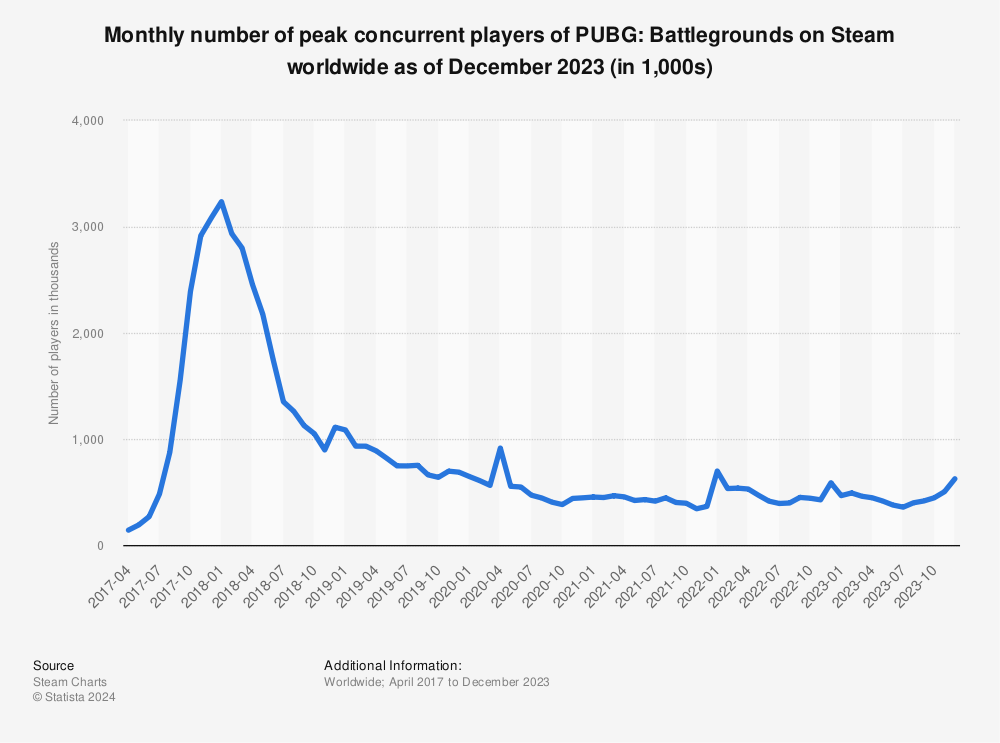PUBG and its Highest Strategic Principle
Saturday 9 January 2021 - Filed under Default
“GG.” The fourth circle just popped. Your squad is strung out on a long rotation in the blue. You’re almost to safety but one of your mates got knocked off a bike by an uncanny bolt. Meds running low and prospects uncertain, you scout and crash the only compound that’s free. Half the lobby’s still alive but for you the game’s already over.
PUBG and the game’s highest strategic principle, ignorance of which plays a key part in your squad’s demise, are sadly undervalued.
First, a bit about the game. The story in PlayerUnknown’s Battleground is you parachute into a map with 64 or 100 ex-cons with nothing but the clothes on your back. You collect weapons, ammo, and armor and fight with other players in hopes of being the last man standing. If you survive, you are greeted with congratulations. WINNER WINNER CHICKEN DINNER. Forcing gameplay toward a single point in the map is the blue zone, which delivers damage every second, in ticks that increase as the game progresses.

Find more statistics at Statista
PUBG popularized the genre now known as Battle Royale. Starting as a mod in Arma 2, realism a core value in its development. Everything in the game is as real as possible while maintaining playability. Guns, buildings, terrain, vehicles, even sound eschew the cartoony norm of today’s most popular games, perhaps giving the illusion that players and viewers are learning real combat skills. Gamers love to quibble about changes that deviate from this theme but no other game comes PUBGs implementation of this core idea.
Professional gamers tend to be in the high teens, early twenties due to the combination of sensory and motor skills needed to play at the highest level. As an ubercasual, there are things I just can’t see. The best PUBG players have an ungodly talent for spotting pixels out of place, their optical pre-processing circuits tuned to the smallest of flickers. Vision is really important but so is sound. Experienced players can tell which floor someone is on, their direction, and are subconsciously tuned into every step. All of this is foundational to the game’s tactical aspects.
When an enemy is located the quickest kill is often via automatic fire, a spray of bullets at their head. This would be easy if it weren’t for recoil. Naively hold down the fire button and your weapon’s muzzle will reach for the sky. So players develop recoil control, dragging the mouse down at a precise speed tuned to each weapon configuration, making fine adjustments to maximize headshots. The game got a training mode, but practicing your sprays just took a lot of time in the early days. Ammo, the lobby, and looting up, all cost time. Even with bots and training mode, getting good enough at this game to win a chicken dinner takes hours a day for a couple months.
The greatest challenge of the game however is mental. Modeling other players movements engages a rare social combat center in our brains. Randall Monroe (of XKCD fame) described for any room, considering how best to survive if raptors were to attack. This is that, but it’s people with modern weaponry instead.
Tactics span from the micro – anticipating which room a player might camp or window they may vault – to the macro, hearing distant gunfire and getting in position to intercept them as they “get in”. The micro means knowing scores of building types in the game, details of bridges, dips, rocks, and trees plus being good with guns and throwables. Macro is about timing, rotational, choke points, lines of sight, and managing inventory to maximize your chances of a dinner.
Professional play is focused on squads where team dynamics are important. Four players in a squad will often choose someone as leader, a role where you’ve got to have it all, to be able to quickly direct players to premium positions and decisive assault. Great teams achieve a sort of mind-meld where and communication is limited to enemy movement, vehicle/loot locations, and trolling.
One thing that always puzzled me was the certainty some showed in saying they need to crash this compound or take a dip when often there were safer options options available. Heat of battle and fog of war understood I did some research, I ran across videos where this kind of macro-tactical-thinking was explained. It all seems to come down to quality of position. A path toward likely game endings. The next circle is randomly placed within certain bounds so can’t be known exactly but this sort of thinking means you value and fight for positions that have a high probability of a playable path toward the final center of the zone.
After learning this, it pains me to see squads waste their time on dead-ends, prolonging the inevitable. I’m comfy here in my armchair but I’m doing what I can to highlight a strategic principle. Player, spectator, or otherwise I am inspired by Sun Tzu when he said, “Opportunities multiply as they are seized.”
Like this strategic principle, the game itself has huge potential but is under-appreciated. While the numbers have steadily decayed since 2018, PUBG Corporation seems to be finally listening to the community, addressing long-time asks like Solo Ranked, and player numbers have started to creep up. Either way, it’s hard to summarize all that can be learned from the game, even harder than getting that Chicken Dinner.
If you’d like to see random posts about software, culture, and life, subscribe to the newsletter or check my linketr.ee, and thank you for reading!
2021-01-09 » David Sterry